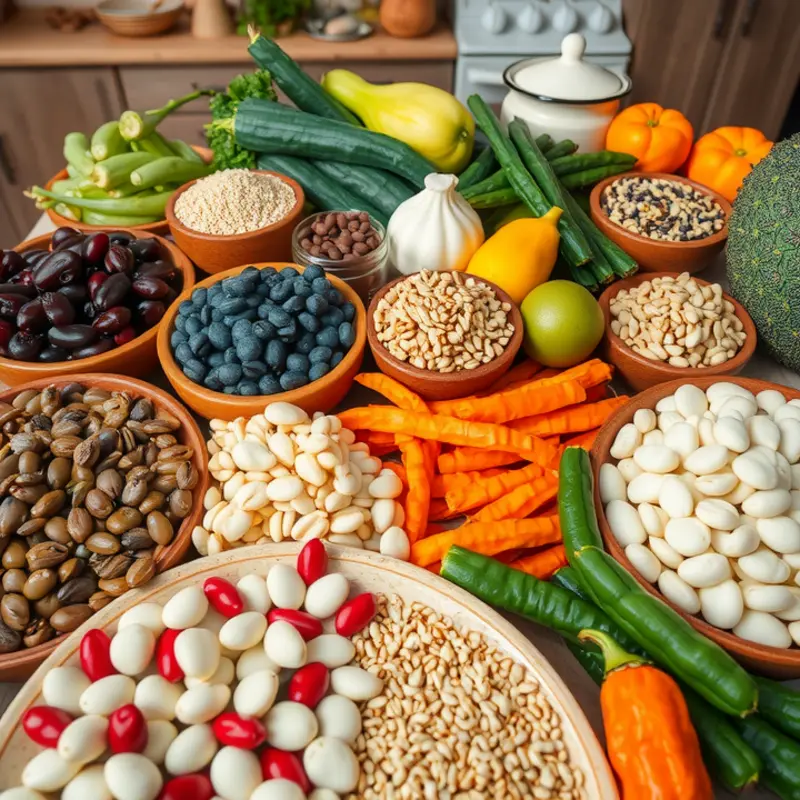Incorporating high-fiber ingredients into daily meals transforms not only the health benefits but also the flavor profiles of your dishes. Fiber is essential for digestive health, promotes satiety, and can help regulate blood sugar levels. This guide provides practical insights on high-fiber ingredients, easy substitutions, and flexible cooking approaches to inspire both home cooks and the health-conscious individuals. By embracing these ingredients, you’ll create delicious meals and enhance your nutritional intake effortlessly.
High-Fiber Powerhouses: Essential Ingredients

Boosting the fiber content in your meals can be as simple as choosing the right ingredients. Beans, lentils, whole grains, fruits, and vegetables are your best allies in this quest. These ingredients are not only rich in fiber but also packed with essential nutrients that support overall health.
Beans and Lentils: Legumes like chickpeas, black beans, and lentils are fiber superstars. One cup of cooked lentils offers about 16 grams of fiber, almost half the daily recommendation. To maximize their benefits, soak dried beans overnight to reduce cooking time and improve digestibility. For canned beans, rinse them well to remove excess sodium. Consider adding them to salads, soups, and stews for a fiber boost.
Whole Grains: Whole grains retain their bran and germ, making them richer in fiber than refined grains. Oats, barley, quinoa, and brown rice are excellent choices. Opt for steel-cut oats over instant varieties for more fiber. Store grains in airtight containers to preserve their freshness. Incorporate these into your diet by preparing grain bowls or using them as a base for stews and stir-fries.
Fruits: Among fruits, berries and apples are particularly fiber-rich. A cup of raspberries provides 8 grams of fiber. Eating fruits with their skins on enhances fiber intake. Store ripe fruits in the refrigerator to prevent spoilage. For a delicious, high-fiber dessert, top Greek yogurt with mixed berries and nuts.
Vegetables: Vegetables like broccoli, Brussels sprouts, and carrots are incredibly fibrous. Steam or roast these vegetables to retain their nutrients and flavor. When shopping, choose fresh vegetables with vibrant colors and firm textures. A great way to integrate more vegetables is by pureeing them into sauces or soups, adding both nutrition and body.
Selecting, storing, and preparing these high-fiber powerhouses carefully will ensure maximum nutritional benefit and taste. Proper storage in eco-friendly containers helps maintain their quality and reduces waste, aligning with sustainable practices. If you’re looking for more efficient ways to store these ingredients, check out these eco-smart kitchen storage solutions.
By incorporating these ingredients thoughtfully, not only will you elevate your meals, but you’ll also enhance your dietary fiber intake, contributing to better digestion and overall wellness.
Smart Substitutions: Boosting Fiber Effectively

Elevating the fiber content in your meals doesn’t require a complete overhaul of your diet. Simple substitutions in everyday recipes can make a significant difference. By adopting whole grains and adding fiber-rich ingredients creatively, you can maintain flavor while bolstering nutritional value.
Swapping out refined, white pasta for whole grain versions is an impactful first step. Whole grain pasta retains more fiber because it contains all parts of the grain. This swap not only enhances fiber content but also adds a nutty taste and firmer texture, resulting in a more satisfying dish. Similarly, replace white rice with brown rice or quinoa. Quinoa is especially beneficial as it provides a complete protein and a high fiber content, making it a versatile option for various dishes.
Instead of regular bread, select whole grain or sprouted grain bread. These breads maintain the bran, germ, and endosperm of the grain, offering a richer source of fiber. Using these varieties for sandwiches or toast can increase dietary fiber intake with minimal change in routine. When baking, you can also substitute a portion of refined flour with whole wheat or almond flour to boost fiber content without altering the beloved flavor profile of your creations.
Legumes are another excellent way to increase fiber with little effort. Substitute half the meat in dishes like tacos or chili with beans or lentils. These ingredients not only increase fiber but are also rich in protein, making them a nutritious addition. Incorporating legumes into soups or salads can also easily raise fiber levels.
For smoothies, consider adding a tablespoon of chia seeds or flaxseeds. Both offer a significant fiber boost as well as omega-3 fatty acids. Chia seeds can absorb liquid, creating a thicker texture, which adds satisfying body to your smoothies.
Nuts and seeds are another simple yet effective addition. Use ground flaxseed in yogurt or sprinkle sunflower seeds over salads. These ingredients enhance not only the fiber content but also add an interesting crunch and flavor depth to your meals.
If you’re concerned about meat-based meals, consider plant-based alternatives. Many of these options are naturally higher in fiber and can be used in myriad ways. For more inspiration on plant-based eating, this easy plant-based eating guide offers practical advice and delicious recipes.
Remember, fiber-rich diets are not only about adding ingredients but also about enhancing flavors and textures creatively. Experimenting with these smart substitutions can lead to exciting culinary adventures, proving that nutritious and tasty meals can indeed go hand-in-hand.
Final words
Integrating high-fiber ingredients into your meals not only boosts health benefits but also encourages culinary creativity. With the ingredient guide and substitution tips outlined, you can easily enhance your meals with nutritious choices that keep you feeling full and satisfied. Whether it’s swapping out ingredients or trying new recipes, embracing high-fiber foods paves the way for a vibrant, health-conscious lifestyle. Remember, small changes can lead to substantial health improvements, so start slowly and enjoy the journey towards a more fiber-rich diet.







